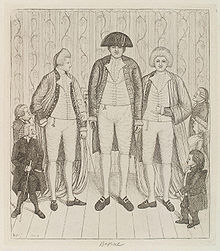- Charles Byrne (giant)
-
Charles Byrne (1761 – 1783), also known as Charles O'Brien or "The Irish Giant", was a human curiosity or freak in London in the 1780s. Byrne's exact height is of some conjecture, but most accounts refer to him as from 2.48 m (8 ft 2 in) to 2.54 m (8 ft 4 in) tall; however, skeletal evidence places him at just over 2.31 m (7 ft 7 in).
Byrne's family lived in a remote part of northeast Tyrone called Drummullan, not far from the shores of Lough Neagh. It is said that Byrne had been conceived on top of a haystack, and that this was the cause of his great height, as if there was a connection between the act of conception and Byrne being a giant. Little is known of Byrne's family other than that his parents were ordinary people, and that they were not unusually tall.[1]
At the age of 21 he left his home in Littlebridge, Ireland, and traveled to London to seek his fortune. He found work at Cox's Museum, an establishment not unlike P. T. Barnum's American Museum. He moved in next door in an elegant apartment with custom-built furniture at the cane-shop, in Spring Garden-gate.
He soon became the toast of the town; a 6 May 1782 newspaper report bears out: "However striking a curiosity may be, there is generally some difficulty in engaging the attention of the public; but even this was not the case with the modern living Colossus, or wonderful Irish Giant."
Fame and wealth soon overtook Byrne, and he took to drinking excessively. According to newspaper reports he was out drinking when his pocket was picked of his 700-pound life savings. Inconsolable, he tried to drown his sorrows in drink and died in June 1783, in his apartment on Cockspurstreet, Charing Cross, at the age of twenty-two.
It was rumoured that he was so afraid that doctors would dissect his corpse that on his deathbed he requested to be buried at sea. Against his wishes, Byrne's corpse was purchased by John Hunter for five hundred pounds (2011: £50,000) , and his 2.31-m (7 ft 7 in) skeleton now resides in the Hunterian Museum at the Royal College of Surgeons in London.
One journal allegedly states that on his death, "The whole tribe of surgeons put in a claim for the poor departed Irishman and surrounded his house just as harpooners would an enormous whale."
Medical condition
The American surgeon Harvey Cushing studied Byrne's bones in 1909 and found that Byrne had had a pituitary tumor based on an enlarged pituitary fossa.[2] In 2011, British and German researchers determined the cause of Byrne's gigantism. They extracted DNA from Byrne's teeth and found that he had a rare mutation in his AIP gene that is involved in pituitary tumors.[3] The researchers also found that four contemporary families living in Northern Ireland that had a history of related pituitary disorders also carried this mutation. The researchers inferred that Byrne and these families had a common ancestor about 57 to 66 generations ago (1425 to 1650 years ago).
Legacy
Author Hilary Mantel wrote a fictionalized novel of his life in The Giant, O'Brien. The plot of the novel focused on the battle between the revolution of science and the ways of poem and song. O'Brien (Byrne) was portrayed as a man whose faith was in tales of kings and the little people, while his polar opposite John Hunter was portrayed as at the dawn of the scientific age, destroying all that is old and cherished. It also mentions that O'Brien (Byrne) was related to another Irish giant in Patrick Cotter O'Brien of Cork, who exhibited himself shortly after the death of Charles, stating that he was 8'7" in height. An exhumation of his bones in 1972 showed that his true height was 8'1". The book also mentions a sort of kinship with two other Irish giants known simply as 'The Brothers Knipe' who both stood 7'2" each. They were recognized by the Guinness Book of World Records as the tallest identical twins in history.
He is mentioned in Ch. 32 of Charles Dickens' novel David Copperfield, to illustrate the enormousness of an umbrella: "But her face, as she turned it up to mine, was so earnest; and when I relieved her of the umbrella (which would have been an inconvenient one for the Irish Giant), she wrung her little hands in such an afflicted manner; that I rather inclined towards her."[4]
References
- ^ Cubbage, Eric. "The Tragic Story of Charles Byrne “The Irish Giant”". The Tallest Man. http://www.thetallestman.com/pdf/charlesbyrne.pdf. Retrieved 1 May 2011.
- ^ Gina Kolata (5 January 2011). "Charles Byrne, Irish Giant, Had Rare Gene Mutation". New York Times. http://www.nytimes.com/2011/01/06/health/06giant.html?_r=2&ref=health. Retrieved 6 January 2011. "And there the bones remained, studied in 1909 by the renowned American surgeon Harvey Cushing, who removed the top of the skull and pronounced that Mr. Byrne had had a pituitary tumor."
- ^ Chahal, Harvinder S.; Stals, Karen; Unterländer, Martina; Balding, David J.; Thomas, Mark G.; Kumar, Ajith V.; Besser, G. Michael; Atkinson, A. Brew et al. (2011). "AIP Mutation in Pituitary Adenomas in the 18th Century and Today". The New England Journal of Medicine (Massachusetts Medical Society) 364 (1): 43–50. doi:10.1056/NEJMoa1008020. http://www.nejm.org/doi/full/10.1056/NEJMoa1008020#t=abstract. Retrieved 6 January 2011.
- ^ Dickens, Charles (1869). David Copperfield. http://en.wikisource.org/wiki/David_Copperfield/Chapter_XXXII. Retrieved 6 January 2011.
Categories:- People with gigantism
- People from County Londonderry
- 1761 births
- 1783 deaths
- Sideshow performers
- Irish entertainers
Wikimedia Foundation. 2010.


